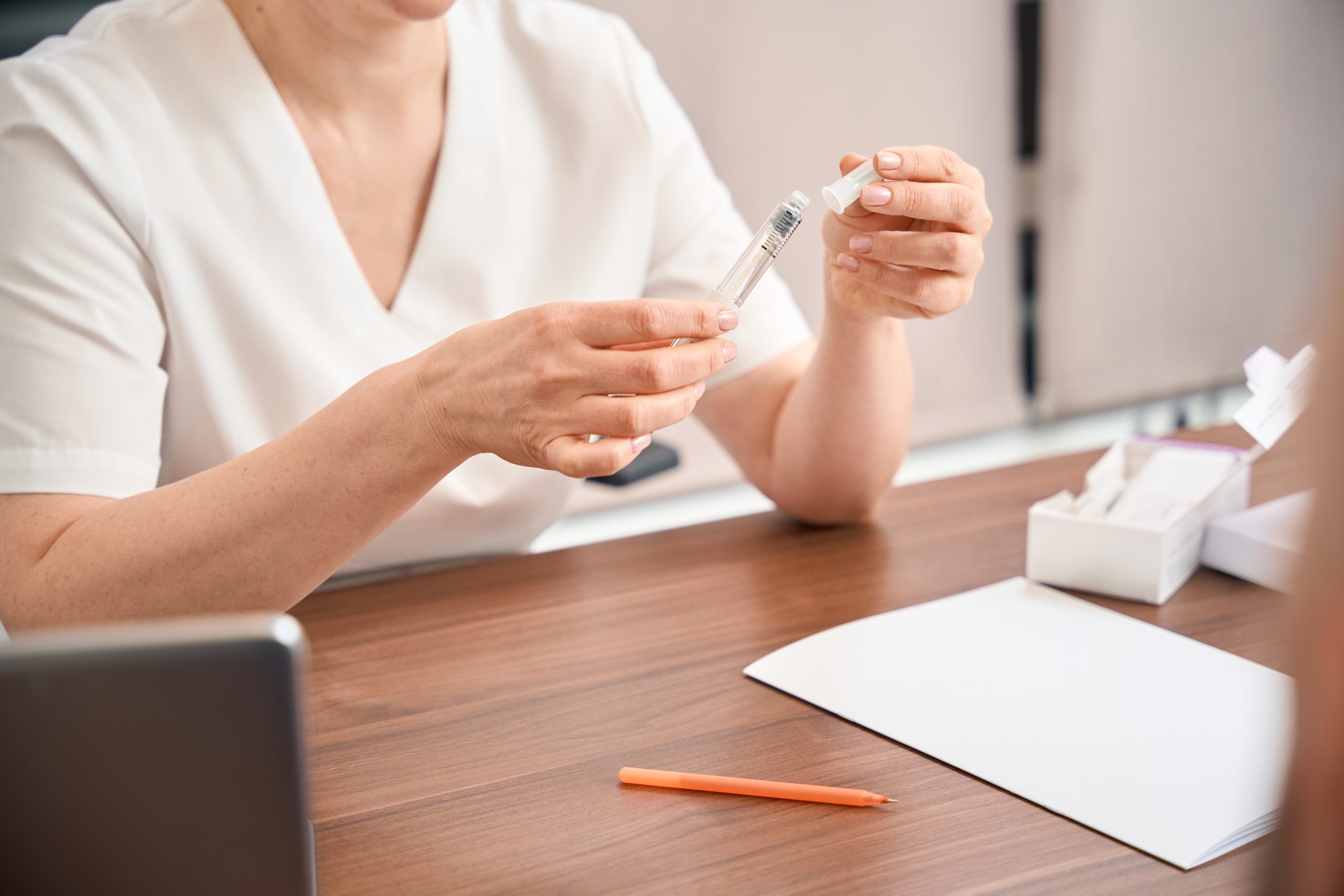IVF Shots & Injectables: Everything You Need to Know

In vitro fertilization (IVF) is a complex process that involves the use of various injectable hormones, commonly referred to as “IVF shots.”
Various injectable medications are used to stimulate the ovaries to produce multiple eggs, delay and control ovulation, and prepare the body for embryo transfer. Understanding the types of IVF shots, their purposes, and how they are administered can help you feel more informed and comfortable throughout your IVF journey.
In this article, we will explore the different IVF shots, their roles in the IVF process, and provide tips for managing the injection regimen.
What are the IVF Shots For?
There are different injectable medications for each stage of the IVF process. This includes medications for:
- Growing multiple eggs
- Preventing/delaying ovulation
- Triggering the final maturation of eggs
Some IVF cycles may also include injectable medications to support endometrial lining development and receptivity. We will go over each of these below.
Shots for Growing Multiple Mature Eggs
Human reproduction is generally inefficient, with only one egg being fully developed each month.
Various injectable medications are used to help multiple eggs grow and thus increase the quantity of eggs that reach maturity each month. This is one of the most important ways in which IVF works and leads to the fastest time to pregnancy of any unassisted natural or assisted reproductive measure.
Follicle Stimulating Hormone (FSH) Injections (Gonal F, Follistim)
- Use: Directly stimulates follicle/egg growth in the ovaries to produce multiple eggs
- Frequency: Taken daily for approximately 10 days
- Mechanism: Increases FSH levels in the blood to promote the growth of multiple follicles, aiming for superovulation.
- The most common medication used to stimulate egg development in IVF
Human Menopausal Gonadotropins (hMG) (Menopur)
- Use: Directly stimulates follicle/egg growth in the ovaries to produce multiple eggs
- Frequency: Often optional – taken daily for approximately 10 days
- Mechanism: Contains equal parts FSH and LH, which work together to stimulate follicle growth.
Micro-dose hCG (containing LH)
- Use: Stimulates the follicular/egg development
- Frequency: Often optional – taken daily for approximately 10 days
- Mechanism: hCG is similar in structure to LH and can bind to LH receptors on the ovarian follicles. This binding stimulates the follicles to grow and mature in ways that mimic the natural LH that occurs in a typical menstrual cycle.
Shots for Preventing Premature Ovulation
In a stimulated IVF cycle, the aim is to have the majority of follicles reach a similar stage of development without allowing the leading follicle to ovulate prematurely.
Since follicles grow at different rates, it’s crucial to prevent the most mature egg from being released before the less developed eggs are ready for retrieval.
Cetrotide & Ganirelix
To help synchronize the maturation of eggs, your fertility specialist may prescribe Cetrotide or Ganirelix. These subcutaneous injections are GnRH antagonists and are administered for three to six days, starting approximately 6 days after FSH is started.
These medications compete with the body’s natural GnRH for receptor binding, quickly inhibiting the secretion of Luteinizing Hormone (LH) to prevent premature ovulation.
Shots to “Trigger” the Final Maturation of Eggs
Trigger shots are taken on one or two separate days to initiate the final stages of oocyte maturation after about 10 days of FSH (and sometimes LH) administration.
One or both of the below medications may be used as a trigger in IVF.
Lupron (GnRH Agonist)
- Use: To induce the final stages of oocyte maturation. Triggering with Lupron only may help reduce the risk of ovarian hyperstimulation syndrome (OHSS) for those who are considered high risk.
- Mechanism: Stimulates a natural surge of luteinizing hormone (LH), mirroring the body’s ovulation process.
hCG (Human Chorionic Gonadotropin)
- Use: For inducing final stage of oocyte maturation and preparing eggs for retrieval. Though it carries a higher risk of OHSS for those that are considered high risk compared to Lupron in some cases,. hCG is the most common trigger used in IVF protocols.
Key Differences
- OHSS Risk: Lupron has a much lower risk of a cycle leading to OHSS for those that are considered high risk, making it preferable for women prone to this condition, such as those with PCOS, high AMH, or those who appear at risk for OHSS as detected by monitoring during a previous cycle.
- Reliability: hCG is generally more reliable for ensuring final egg maturation but increases the risk of OHSS.
- Combination Therapy: Lupron may be combined with a low dose of hCG to balance OHSS risk and ensure effective egg maturation.
Shots to Support Implantation
Injectable IVF medications not only stimulate egg production but also support implantation of the embryo in the uterus.
Progesterone
Progesterone is crucial for preparing the uterine lining to receive an embryo and, helping to maintain pregnancy.
A medicated embryo transfer (also known as a non-ovulatory cycle), means that you will not produce your own progesterone. Because of this, we have to completely replace progesterone with a form of progesterone called progesterone in oil (PIO). Vaginal forms of progesterone may also be added for extra support.” Progesterone in oil shots will be continued until either a negative pregnancy test, or, if the test is positive, until around the 10th week of pregnancy. By that time, the placenta will take over progesterone production.
Generic: progesterone
Brands: Endometrin, Crinone, Prometrium
Prednisolone
Prednisolone, a corticosteroid, suppresses immune responses and inflammation. It is used in fertility treatments for women with recurrent miscarriages or elevated natural killer (NK) cells and for men to reduce anti-sperm antibodies. Short-term use begins with stimulation medication in women.
Generic: prednisolone
Brand: Prednisone
Supplementary Shots to Improve Oocyte Quality
Human Growth Hormone (HGH)
HGH injections are recommended for women with poor ovarian responses or decreased ovarian sensitivity to gonadotropins. It supports oocyte maturation and improves egg quality, particularly in women with low ovarian reserve.
Generic: somatropin
Brand: Omnitrope
Why Injectable Medications?
Injectable medications are essential in IVF treatment because they allow for precise timing and dosage. Unlike oral medications, which must pass through the digestive system, injections deliver medication directly into the bloodstream, ensuring faster and more effective results. You cannot take these medications in pill form because these peptide hormones would break down in your stomach, making a pill form ineffective. During IVF, patients typically administer daily injections at home, making the process more convenient.
Injection Sites
IVF treatment involves various injectable medications tailored to individual infertility conditions. The two main types of injections are:
Subcutaneous Injections
These injections are administered just beneath the skin, typically in the abdomen, arm, or thigh. Most IVF medications are given this way for ease and effectiveness.
Intramuscular Injections
Injecting medication directly into the muscle is commonly used for the progesterone in oil shots but, in general, not for other medications. Intramuscular injections are usually administered in the upper outer quadrant of the buttocks.
How to Take IVF Injections at Home
Your fertility specialist will provide detailed instructions based on the type of IVF injection prescribed. Here are general steps for using a pre-filled pen:
Prepare the Environment
- Ensure a clean, sterile area for the equipment.
- Wash your hands thoroughly before handling any materials.
Gather Equipment
- Reusable injection pen/disposable needle and syringe
- Alcohol swabs
- Sterile gauze pads and bandages
- Needle disposal container
Prepare the Medication
- Set the correct dose on the injection pen or draw the medication into the syringe.
- Remove air bubbles by holding the syringe needle upward and gently pushing the plunger until a droplet appears at the tip. Recap the needle until it is ready for use.
Prepare the Injection Site
- Clean the site with an alcohol swab and allow it to dry.
- Common injection sites include the abdomen, arm, or thigh.
Administer the Injection
- Remove the needle cap.
- Pinch the skin at the injection site with your thumb and fingers.
- Firmly insert the needle into the skin at the proper angle.
- Inject the medication slowly and steadily.
Post-Injection Care
- Place a gauze pad over the injection site and secure it with a bandage if needed.
- Dispose of the needle safely in a designated container.
How Many Shots Do You Need During IVF?
During IVF, the number of shots varies per individual treatment plan but generally includes daily hormone injections over about 10-12 days. This includes follicle-stimulating hormones (FSH) and sometimes human menopausal gonadotropins (hMG) or LH to stimulate egg production. You may also have an injection to prevent ovulation, as discussed above (this depends on your protocol).
Additionally, a trigger shot of hCG or Lupron is given to induce final egg maturation.
Progesterone injections may continue daily after egg retrieval to support the uterine lining.
Overall, a typical IVF cycle can involve between 30-90 injections, depending on the specific medications and protocols prescribed by your fertility specialist.
Tips for Administering Your IVF Shots
During infertility treatment, you will receive detailed instructions to ensure the safe and effective administration of injectable medications.
With practice, you will develop a technique to minimize discomfort. Use small needles, pinch the skin, and inject at a 45-degree angle, withdrawing the needle slowly.
To ease tension, practice deep breathing before and during injections. Take a deep breath, and as you release it slowly, inject the medication.
Rotate injection sites to avoid bruising, inflammation, and soreness. You may find one side more comfortable than the other.
After each injection, use an ice pack on the site to reduce swelling and discomfort. You may also use an ice pack beforehand to numb the injection site, although this may not be needed.
Finally, reward yourself with a treat, a relaxing bath, or a walk to maintain a positive mindset.
Potential Side Effects of IVF Shots
Though the standard regimen of IVF injections is well tolerated by most patients, as with any medication, there are some potential side effects to be aware of.
Common side effects include mild nausea, bloating, headaches, and hot flashes. Injection sites may experience pain, redness, or irritation.
Serious side effects require immediate medical attention and include allergic reactions (such as rash, itching, or swelling of the face, lips, or tongue), difficulty breathing, and severe stomach pain with nausea or vomiting.
Some patients may experience pelvic pain or bloating. Using hormonal medications like FSH, hMG, or Lupron can sometimes lead to ovarian hyperstimulation syndrome (OHSS), characterized by swollen and painful ovaries.
It’s essential to follow your fertility specialist’s guidance and report any severe or persistent side effects to ensure your treatment remains safe and effective.
IVF Shots: The Takeaway
In vitro fertilization (IVF) involves various injectable hormones, crucial for regulating a woman’s hormonal cycle, stimulating the ovaries, and preparing the body for embryo transfer.
These injections, administered subcutaneously or intramuscularly, are tailored to individual needs and help maximize the chances of successful fertilization and implantation.
By following detailed instructions and managing potential side effects, patients can navigate the IVF journey effectively. The right combination of medications, along with professional guidance, can significantly enhance your likelihood of achieving a successful pregnancy.


